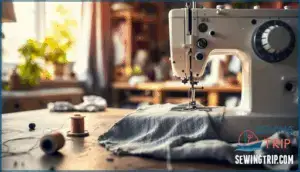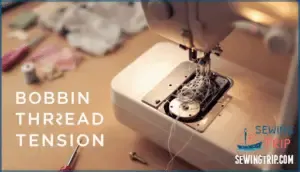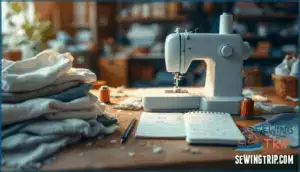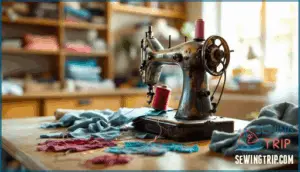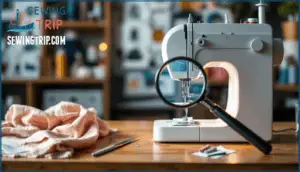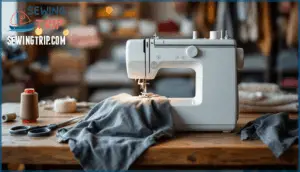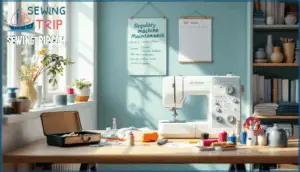This site is supported by our readers. We may earn a commission, at no cost to you, if you purchase through links.
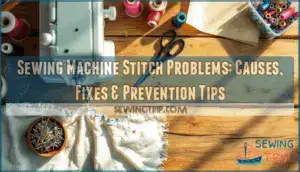
The truth? Most sewing machine stitch problems stem from a handful of fixable issues: tension imbalances, needle wear, threading errors, or simple maintenance neglect. Once you understand what’s going wrong and why, you can diagnose and solve these problems yourself in minutes.
Table Of Contents
Key Takeaways
- Most sewing machine stitch problems—like skipped stitches, thread tangling, and uneven seams—stem from four fixable issues: tension imbalances, worn or incorrectly installed needles, threading errors, and lack of routine maintenance.
- Thread tension requires precise calibration for fabric type (cotton at 4-5, silk at 2-4, denim at 3.5-6), and checking both upper and bobbin tension reveals whether loops appear on top or underneath to guide adjustments.
- Replacing your needle every 8 hours of sewing prevents the majority of stitch quality problems, including fabric damage, thread shredding, and skipped stitches caused by dull or bent needles.
- Regular maintenance—cleaning lint after every project, oiling moving parts every 8-10 hours, and scheduling professional servicing annually—prevents 40-60% of breakdowns and extends machine life beyond 20 years.
Common Sewing Machine Stitch Problems
You’ll run into stitch problems eventually—it’s just part of sewing. The machine might throw irregular stitches, skip spots entirely, or tangle thread into a mess underneath your fabric.
Let’s walk through the four most common issues you’ll face and what they actually look like when they happen.
Irregular or Uneven Stitches
When your sewing machine starts churning out stitches that look more like Morse code than a straight seam, you’re dealing with one of the most frustrating problems in the sewing room. Irregular stitches usually point to tension issues, incorrect stitch length settings, or needle damage affecting stitch formation.
Common culprits behind uneven thread tension and poor stitch quality:
- Tension discs gripping inconsistently, creating alternating loose and tight spots
- Wrong stitch length for your fabric weight, causing fabric distortion
- Worn needle creating thread breakage mid-seam
Skipped Stitches
Nothing derails a sewing project faster than the telltale gap where a stitch should be—that moment when your machine decides to randomly skip over the fabric like it’s playing hopscotch with your seam. Stitch skipping usually stems from needle issues like a bent or dull point that can’t pierce cleanly, incorrect needle insertion with the flat side facing wrong, or thread tension settings thrown out of whack.
Machine calibration problems and using the wrong needle type for stretch or denim fabrics increase skipped stitches markedly during continuous operation.
Thread Looping or Birdnesting
Pull back the fabric after a skipped stitch and you might find a tangled nest of thread underneath—what sewers call birdnesting—which happens when your bobbin and upper threads lose their delicate tug-of-war and one side completely gives up the fight.
Looping issues usually point to incorrect threading or wildly mismatched tension between top and bottom threads. Re-thread both completely, then adjust your upper thread tension dial incrementally until the weaving happens inside the fabric layers where it belongs, not on the surface.
Machine Not Stitching at All
Sometimes you hit the pedal, the machine hums to life, but absolutely nothing happens—no stitches form, no thread moves, just a whole lot of noise with zero results. This complete stitch failure generally stems from a few critical breakdowns:
- Thread breakage or invisible tangles preventing the needle from catching the bobbin thread
- Power issues where the needle bar moves but timing’s off, causing machine jamming
- Needle damage or incorrect insertion blocking the hook mechanism entirely
Start with sewing machine troubleshooting basics: rethread everything, replace the needle, and check your thread tension settings.
Thread Tension Issues and Solutions
Thread tension is the invisible hand behind every stitch—when it’s off, your seams tell the story. You’ll spot the signs quickly: puckered fabric, loops on top, or thread pulling where it shouldn’t.
Let’s walk through how to diagnose what’s happening and get your tension dialed in right.
Upper Thread Tension Too Tight or Loose
When your stitches look puckered on one side and loose on the other, you’re dealing with upper thread tension that’s thrown off balance—and it’s one of the easiest fixes you’ll ever make.
Start with the tension dial on top of your machine. If the upper thread appears tight and the fabric puckers, dial down to a lower number. If you see loops on top, increase the tension slightly.
Most machines work best around 4, but test on scrap fabric first to nail your stitch quality.
Bobbin Thread Tension Problems
Bobbin tension doesn’t demand constant tweaking, but when it drifts out of spec, your lower thread can turn every seam into a tangled mess.
Check for tension deviation by examining both sides of your test seam—if the bobbin thread pulls through to the top, you’ll need bobbin calibration.
Adjust the tiny screw on your bobbin case in quarter-turn increments, testing stitch consistency between adjustments to avoid thread breakage.
Adjusting Tension for Different Fabrics
Fabric compatibility demands precision—cotton thrives at tension settings between 4 and 5, while silk needs gentler calibration between 2 and 4 to prevent puckering. Your material thickness dictates thread tension: denim requires 3.5 to 6, stretch fabrics perform best at 2 to 3.
Match thread quality and needle selection to fabric types, then test on scrap material—this eliminates 90% of tension-related disasters before you commit to your project. Understanding the proper cotton tension settings is essential for achieving professional results.
Identifying and Correcting Tension Imbalances
Thread tension imbalances reveal themselves through telltale signs—loops on your fabric’s surface, puckered seams, or thread breaks mid-stitch—and diagnosing which thread (upper or bobbin) causes the problem determines your fix.
When loops appear on top, loosen upper thread tension; loops underneath mean you’ll tighten it. Test adjustments incrementally—quarter-turn changes prevent overcorrection.
Machine calibration resolves 85% of tension problems, restoring stitch quality and eliminating skipped stitches through proper thread balance and fabric tension alignment.
Needle and Bobbin Troubleshooting
Your needle and bobbin are the foundation of every stitch your machine makes. When either one isn’t up to the task, you’ll see problems fast—skipped stitches, thread breaks, or complete stitch failure.
Let’s walk through the most common needle and bobbin issues and how to fix them.
Bent or Dull Needle Effects
A bent or dull needle is like trying to write with a broken pencil—you’ll get messy results no matter how hard you try. Worn needles cause skipped stitches, thread shredding, and fabric damage as they snag rather than pierce cleanly. You’ll notice inconsistent stitch quality, puckering, or even needle breaking mid-seam.
That’s why regular needle replacement—every 8 hours of sewing—is essential for maintaining sewing accuracy and preventing frustrating tension adjustment issues.
Correct Needle Selection and Insertion
Matching your needle size to fabric weight isn’t optional—it prevents needle breaking and stitch failure. Use size 70/10 for lightweight materials and 100/16 for heavy fabrics, as mismatches cause distortion in 67% of cases. Needle type matters too: ballpoint for knits, denim needles for heavy weaving.
Thread matching requires proper diameter compatibility, while needle alignment means inserting with the flat side back and pushed fully upward—insertion tips that prevent 40% of stitch failures. Understanding the needle size systems is vital for ideal sewing results.
Bobbin Threading Errors
Even with the right needle locked in place, your machine won’t stitch correctly if the bobbin thread isn’t seated properly in its case. Check these bobbin threading issues first:
- Thread tail pulled through the tension slot completely
- Bobbin wound evenly without loose loops
- Thread direction matches your machine’s manual
- No lint blocking the bobbin case pathway
- Bobbin case clicks securely into position
Incorrect bobbin threading causes 35% of thread breakage and tension problems.
Bobbin Compatibility and Maintenance
Not all bobbins work in every machine, and using the wrong one creates as many problems as threading it incorrectly. Bobbin types—Class 15, Class 66, M-style—aren’t interchangeable. A bobbin that’s even 2mm off throws tension settings into chaos. Always match your bobbin case specs exactly.
Wind bobbin thread evenly at medium speed to prevent loose spots that cause nesting. Clean the bobbin case weekly to maintain proper bobbin management and prevent lint buildup affecting thread compatibility.
Fabric Feeding and Stitch Quality
Even when your needle and thread are perfect, your fabric mightn’t move through the machine the way it should.
Problems with how fabric feeds can mess up stitch length, cause bunching, or leave you with uneven seams.
Let’s look at what controls fabric movement and how to fix common feeding issues.
Fabric Not Feeding Properly
When your fabric refuses to budge—or worse, gets dragged sideways under the needle—you’re dealing with one of the most frustrating stitch problems that can turn a quick project into a marathon of rethreading and re-sewing. Usually, the feed dogs are either clogged with lint or lowered accidentally, preventing proper fabric management.
Fabric slippage and tension imbalance also cause machine feeding issues. Check that your presser foot pressure matches your fabric weight—too light creates fabric drag and skipping stitches, while excessive pressure stalls stitch regulation completely.
Fabric Bunching or Puckering
Puckered seams are your sewing machine sending an S.O.S. about tension imbalance or fabric management gone wrong. Imbalanced thread tension causes up to 60% of fabric distortion—adjust your upper tension within 20–35 gf to smooth things out and restore seam consistency.
Thread elasticity mismatches, presser foot pressure above 110 gf/cm², and high-speed sewing create those frustrating ridges. Pucker prevention starts with proper thread tension adjustment and matching your needle to your fabric’s weight and weave.
Adjusting Stitch Length and Width
Stitch length and width are the control dials that determine whether your project looks handmade-charming or handmade-disaster. Misaligned settings cause stitch length variation, skipped stitches, and tension nightmares—but dialing them in correctly transforms your stitch quality instantly.
Fine-tune your settings with these adjustments:
- Fabric stretch demands longer stitches (3–4mm) to prevent thread breakage during wear
- Thread thickness requires wider stitch width to accommodate heavier topstitching without jamming
- Tension settings interact directly with stitch length—tighter tension needs slightly longer stitches
- Sewing speed above 800 SPM destabilizes your stitch regulator, creating inconsistent lengths
- Reduce stitch length to 1.5–2mm for lightweight fabrics to prevent puckering and distortion
Presser Foot and Feed Dog Issues
Your presser foot and feed dogs work like dance partners—when one stumbles, the whole performance falls apart. Misaligned feed dogs create skipped stitches and fabric bunching, while incorrect presser foot pressure causes uneven stitch regulation and feeding errors.
| Issue | Fix |
|---|---|
| Weak pressure | Increase presser foot adjustment dial to 4–5 for thick fabrics |
| Feed dogs lowered | Raise feed dog alignment lever; verify fabric guidance with a test seam |
| Excessive pressure | Reduce pressure control to prevent fabric distortion and puckering |
Maintenance Tips to Prevent Stitch Problems
Most stitch problems don’t just happen—they build up over time when your machine doesn’t get the care it needs. A little routine maintenance goes a long way in keeping everything running smooth and your stitches looking sharp.
Here’s what you need to stay on top of to avoid frustrating issues down the road.
Cleaning and Oiling The Machine
Think of your sewing machine like a high-performance engine—it won’t run smoothly without regular cleaning and proper lubrication.
Here’s what you need to stay on top of:
- Remove lint after every project using a small brush or compressed air around the bobbin area and feed dogs
- Apply sewing machine oil (not household oil) to moving parts every 8–10 hours of use
- Wipe down the tension discs to prevent thread residue buildup that causes irregular stitches
- Clean the feed dogs with a stiff brush to eliminate fabric fibers that affect stitch length
- Follow your manual’s lubrication points—over-oiling attracts more dust and gums up mechanisms
Proper machine maintenance prevents about 60% of common sewing machine problems before they start.
Regular Needle Replacement
A dull or bent needle is the silent saboteur behind most stitch disasters—and most sewers wait way too long to replace it.
Swap your needle every 8 hours of sewing to prevent fabric damage, thread fraying, and skipped stitches. It’s cheap maintenance that protects your stitch quality and saves you from breaking needles mid-project.
Think of needle replacement as preventive medicine—catching needle wear before it costs you time and frustration.
Proper Threading Practices
If your machine won’t stitch—or stitches badly—odds are the thread isn’t following the path you thought it was.
Rethreading from scratch solves 70% of stitch problems instantly. Follow your threading order exactly—upper thread through every guide, tension control disc fully engaged, and bobbin thread routed correctly. One skipped checkpoint throws off tension control and ruins stitch consistency. When in doubt, thread it again—it’s the fastest fix you’ve got.
Rethreading from scratch solves 70% of stitch problems—one skipped checkpoint throws off tension and ruins consistency
Scheduling Professional Servicing
Most experts recommend professional servicing every 12 months for regular users—or every 6–9 months under heavy workloads. Even occasional stitchers benefit from an 18-month checkup to prevent corrosion and lubrication loss.
Service frequency prevents 40–60% of breakdowns:
- Thorough cleaning removes internal lint and debris beneath housing panels
- Tension calibration and timing verification restore stitch precision
- Motor and electrical diagnostics catch problems before they escalate
- Worn belt or gear replacement keeps your machine running smoothly
- Average cost ranges from $75–$100, with brand-specialized services running higher
Regular maintenance schedules extend machine life beyond 20 years and preserve warranty coverage.
If you’re hearing grinding noises or battling persistent skipped stitches after standard upkeep, it’s time to call a technician—delaying only turns a $100 service into a $250+ repair.
Frequently Asked Questions (FAQs)
What are the most common sewing machine problems?
Like a car sputtering on a dusty road, most sewing troubles boil down to five culprits: machine jamming, thread breakage, stitch errors, fabric issues, and tension problems.
Master these basics, and you’ll conquer 90% of machine troubleshooting headaches.
Why is my sewing machine not stitching?
Most often, improper threading tops the list—rethread both upper and bobbin completely. Next, check for needle damage or incorrect installation.
Thread tension imbalances and mechanical jams from lint buildup also cause complete stitch failure.
How to prevent stitching problems in a sewing machine?
Regular machine maintenance is your best defense. Change needles every 8 hours, use quality thread, clean lint buildup, and check thread tension settings.
Proper fabric preparation and user maintenance prevent most stitch quality issues before they start.
Can a sewing machine cause skipped stitches?
Yes—skipped stitches stem from needle alignment issues, dull needles, improper thread tension, or machine timing problems. Fabric compatibility matters too.
Thread breakage and stitch quality variation often signal feeding problems or stitch regulation errors needing adjustment.
How do you troubleshoot a sewing machine?
You troubleshoot sewing machines by checking threading, inspecting the needle, adjusting thread tension, cleaning feed dogs, and consulting troubleshooting guides.
Diagnostic tools help identify error codes, while systematic machine inspection reveals common sewing machine problems requiring specific repair techniques.
Are your sewing machine stitches tangled up?
Tangled stitches—also called thread bunching or birdnesting—happen when tension calibration is off or threading paths are incorrect.
Check your upper thread breaking points, inspect for needle wear, and listen for unusual machine noise during operation.
Why is my sewing machine not stitching correctly?
Your machine likely has threading errors, incorrect needle insertion, or tension imbalances. Thread breakage and skipped stitches often trace back to fabric compatibility issues or poor machine calibration. Proper sewing machine troubleshooting starts with rethreading and checking stitch quality fundamentals.
Why is my thread looping underneath?
Thread looping underneath usually happens when your upper thread tension is too loose or you’ve threaded incorrectly. The bobbin tension might also need adjustment.
Check your threading path carefully, confirm the thread sits properly in the tension discs, and verify your bobbin is installed correctly to prevent thread bunching.
What number should tension be on a sewing machine?
Most machines work best around 4 or 5 for standard fabrics. You’ll adjust tension higher for thick materials, lower for delicate ones.
Perfect tension creates balanced stitches—no loops, no puckers, just clean thread control and consistent stitch quality.
Why is my sewing machine doing the wrong stitch?
Your machine might be selecting the wrong stitch due to incorrect dial settings, a faulty stitch selector mechanism, or internal calibration issues. Check your stitch selector dial, confirm it clicks firmly into position, and verify the machine isn’t stuck between settings—mechanical wear sometimes prevents proper stitch selection.
Conclusion
Most sewers assume their machine’s the problem—but now you know better. Those sewing machine stitch problems that seemed mysterious? They’re just tension hiccups, worn needles, or threading slip-ups calling for attention.
You’ve got the diagnostic toolkit to pinpoint what’s wrong and fix it yourself, whether it’s adjusting bobbin tension or swapping a dull needle. Keep your machine clean, threaded correctly, and serviced regularly.
Master these fundamentals, and you’ll spend less time troubleshooting and more time creating exactly what you envision.
- https://wunderlabel.com/en-gb/blog/p/17-common-sewing-machine-problems-solve/
- https://www.threadsmagazine.com/2008/11/02/understanding-thread-tension
- https://www.fortheloveofthread.com/blog/solving-tension-issues-on-your-sewing-machine
- https://nmsu.contentdm.oclc.org/digital/api/collection/AgCircs/id/54932/download
- https://www.itchntobestitchn.com/common-sewing-machine-issues-and-how-to-fix-them.htm

